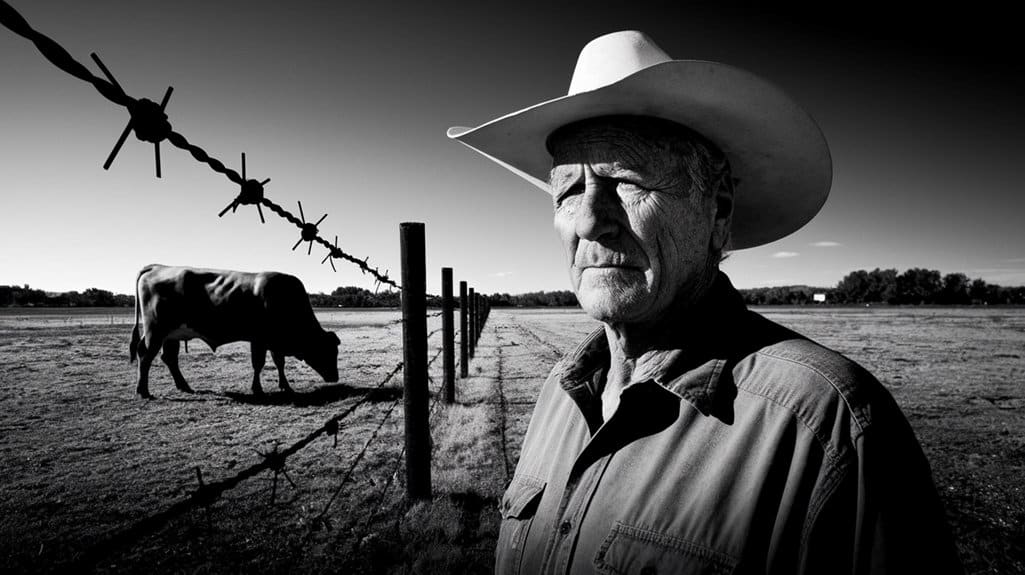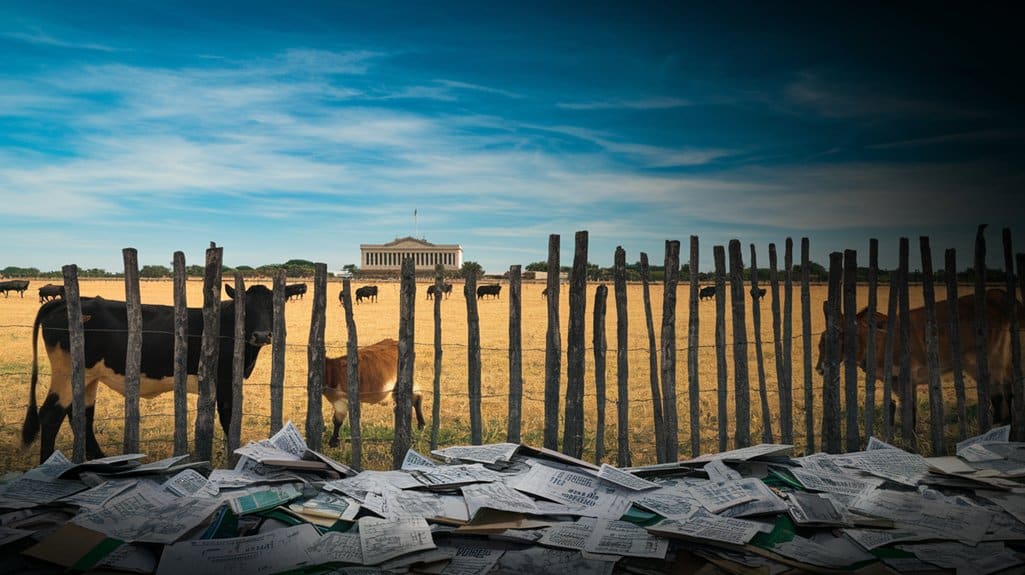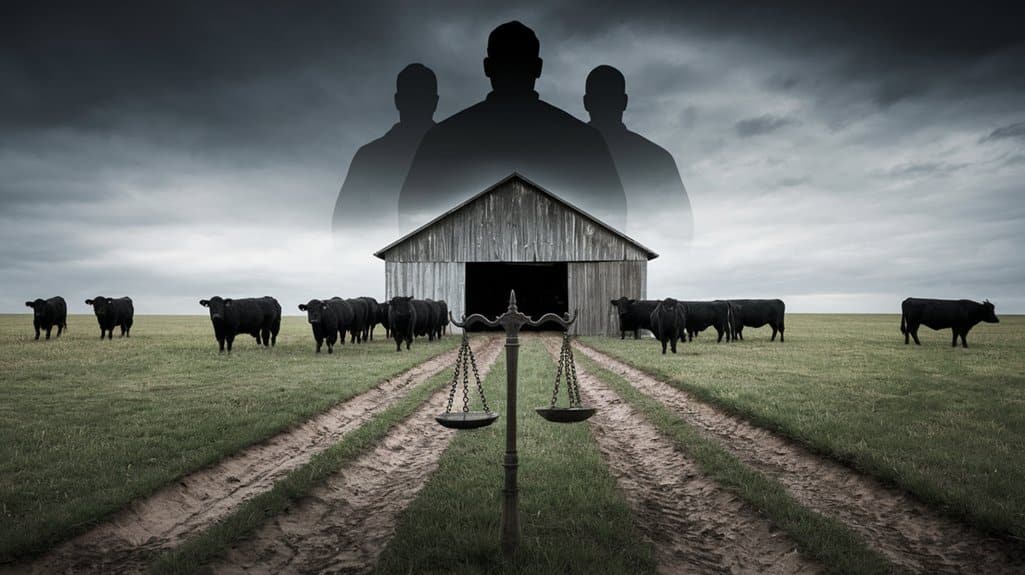Uruguay’s cattle industry faces its biggest scandal in decades, with fraudulent livestock investment schemes leaving 6,000 investors holding empty bags instead of promised profits. The US$300 million fraud has shaken the traditionally stable sector, exposing vulnerabilities in what many considered a foolproof investment. As investigators untangle this financial web, questions emerge about how such a massive deception occurred in a country known for its transparent agricultural markets. The answers might surprise even seasoned traders.
Key Takeaways
- Uruguayan cattle investment schemes defrauded 6,000 investors of US$300 million through false promises of 11% returns on private livestock contracts.
- Conexión Ganadera emerged as the largest fraudulent operator, facing court-ordered asset freezes of $250 million and receivership proceedings.
- Only $158 million is traceable against $384 million in investor claims, indicating significant challenges in fund recovery.
- Four major companies involved: Conexión Ganadera, República Ganadera, Grupo Larrarte, and Paso de los Toros, all facing insolvency or restructuring.
- The scandal exposed regulatory gaps in Uruguay’s cattle investment contracts, prompting calls for enhanced oversight and mandatory external audits.
The Scope of Uruguay’s Cattle Industry Scandal

While Uruguay’s cattle industry has long been a cornerstone of the nation’s economy, a devastating investment scandal has shaken the sector to its core, with fraudulent livestock schemes defrauding approximately 6,000 investors of nearly US$300 million.
The scandal emerged from companies offering seemingly attractive investment alternatives to traditional banking, promising fixed returns of up to 11% through private livestock contracts. These schemes, which operated outside central bank oversight, particularly appealed to middle-class Uruguayans still wary of conventional banking following the early 2000s crisis. The 2022-23 drought caused over US$1.7 billion in losses for the farm sector, further destabilizing the industry. The breakdown of livestock ethics in these operations has exposed significant regulatory gaps, as companies structured their offerings to mimic regulated financial products while cleverly sidestepping official scrutiny. The impact has reverberated throughout Uruguay’s substantial cattle industry, which manages approximately 12 million head of cattle.
Key Players and Companies Under Investigation
The unraveling of Uruguay’s cattle investment scandal has exposed a intricate web of companies and key figures at its center. As regulatory challenges mounted, several major firms faced intense scrutiny for alleged fraudulent practices, with Conexión Ganadera emerging as the largest player in the controversy. The death of key figure Gustavo Basso in a traffic accident only intensified public concern about the scandal’s reach. Approximately 4,300 investors lost millions when the fraudulent scheme came crashing down.
| Company | Status | Impact |
|---|---|---|
| Conexión Ganadera | Insolvent | Assets frozen |
| República Ganadera | Restructuring | Creditor protection |
| Grupo Larrarte | Receivership | $12.3M shortfall |
| Paso de los Toros | Operations halted | Liquidity crisis |
| Scheneck & Others | Challenged | Industry turmoil |
The ripple effects have touched multiple meat packing plants, with facilities like Paso de los Toros suspending operations due to financial entanglements with the troubled firms.
Breaking Down the $300 Million Financial Impact
The staggering $300 million financial impact of Uruguay’s cattle investment scandal reaches far beyond the immediate losses of 6,000 investors, threatening to unravel decades of trust in the nation’s prestigious beef industry. Unlike typical financial frauds confined to a single sector, this crisis has created ripples throughout Uruguay’s middle class, where entire families and social networks collectively invested their savings based on the cattle industry’s sterling reputation. The prospects for investment recovery remain uncertain as investigators maneuver intricate asset freezes and restructuring processes, while the biological urgency of maintaining thousands of live cattle adds a uniquely pressing dimension to the financial resolution. The situation mirrors Venezuela’s recent turmoil where electoral fraud claims have destabilized financial markets and investor confidence.
Market Value Chain Disruption
Unraveling Uruguay’s $300 million cattle investment scandal reveals an intricate web of market disturbances that extends far beyond immediate financial losses. The ripple effects have severely compromised market resilience throughout the livestock sector, forcing a critical reassessment of investment caution across the industry.
The disturbances have manifested in three key areas:
- Meat packing facilities experiencing operational shutdowns, threatening hundreds of jobs and regional economic stability
- Sheep slaughtering operations facing severe financial strain, indicating broader agricultural sector vulnerability
- Supply chain interruptions affecting both domestic and international trade relationships
This cascade of disturbances has fundamentally altered Uruguay’s livestock market dynamics, exposing systemic weaknesses in private livestock contracts and highlighting the urgent need for regulatory reform to protect market integrity. The collapse of what was once a leading firm in Uruguay’s cattle investment sector has left hundreds of investors uncertain about their financial futures.
Investment Recovery Prospects
Beyond the market disturbances lies an even more sobering reality: recovering the $300 million lost in Uruguay’s cattle investment scandal presents a intricate financial puzzle with dim prospects for full restitution.
With only $158 million in traceable assets against $384 million in investor claims, financial experts suggest a multi-year recovery plan might offer the best path forward. Similar to Argentina’s Burford Capital case, where a $17 million investment yielded a $16.1 billion judgment, investors are exploring litigation financing options. New investment strategies and fraud prevention measures are being developed to protect future stakeholders, while current recovery efforts focus on asset seizure and private agreements among affected parties. The Central Bank’s hands-off stance, citing lack of jurisdiction over private livestock contracts, has left investors navigating a intricate web of legal proceedings. This saga serves as a stark reminder that even seemingly solid agricultural investments require robust regulatory oversight and due diligence.
Regional Economic Ripple Effects
While Uruguay’s cattle fraud scandal initially appeared localized, its $300 million financial impact has cascaded through multiple sectors of the nation’s economy, creating a domino effect that reaches far beyond the immediate livestock industry.
The ripple effects have manifested in three critical areas:
- Plummeting investor sentiment across agricultural investments, particularly in cattle futures and related financial instruments
- Disturbance of meat processing operations, threatening thousands of jobs at facilities like Paso de los Toros
- Strain on rural communities where livestock management operations serve as economic anchors
This financial earthquake has exposed vulnerabilities in Uruguay’s agricultural backbone, challenging the nation’s standing as a reliable beef exporter and forcing a painful reassessment of investment practices in the livestock sector. The crisis deepened significantly after fixed annual returns of up to 11% proved unsustainable in the volatile market conditions.
Timeline of Events Leading to Discovery

Several key events unfolded between 2002 and 2022 that ultimately exposed one of Uruguay’s largest cattle investment frauds. Following the 2002 banking crisis, innovative cattle investment schemes emerged, promising attractive returns of up to 11% annually. These schemes flourished unchecked by regulatory changes, gaining momentum through word-of-mouth endorsements and professional marketing.
The facade began crumbling when Grupo Larrarte entered receivership in October 2022, triggering a domino effect that exposed similar issues at Conexión Ganadera and República Ganadera. The COVID-19 pandemic, coupled with severe drought and rising interest rates, had already strained these operations. Investigations revealed a possible Ponzi scheme structure, where new investments were allegedly used to pay earlier investors, leading to approximately $300 million in missing funds. Shareholder lawsuits quickly mounted as investors discovered their assets had vanished.
Legal Actions and Receivership Measures
The legal response to Uruguay’s cattle investment scandal has taken shape through extensive regulatory investigations and court-ordered receivership measures. The central bank’s launch of eleven probes since 2018 has exposed significant investment risks and troubling legal implications across the sector.
Key developments include:
- Court-mandated receivership of Conexión Ganadera, accompanied by a $250 million asset freeze
- Grupo Larrarte’s entry into receivership following revelation of a $12.3 million asset shortfall
- Implementation of dual-track proceedings addressing both debt restructuring and potential criminal charges
The receivership process now focuses on identifying and protecting viable assets, with court-appointed administrators overseeing the intricate task of managing and potentially liquidating company holdings to compensate affected investors, though significant losses appear likely.
Impact on Local and International Investors
The ripple effects of Uruguay’s cattle fraud scandal extend far beyond its borders, with both local and international investors grappling with uncertain recovery prospects. Middle-class Uruguayan families, who invested approximately $300 million through word-of-mouth networks, find themselves at the epicenter of this financial earthquake that has shaken their trust in alternative investments. While local authorities scramble to trace missing funds, international investors and financial institutions are reassessing their exposure to similar livestock investment schemes, potentially triggering a broader reassessment of agricultural investment risk across South America. A devastating 2022-23 severe drought contributed significantly to the financial crisis, causing losses exceeding $1.7 billion in the farming sector.
Recovery Prospects Remain Uncertain
Despite mounting efforts to recover assets from Uruguay’s massive cattle investment scandal, prospects for meaningful restitution remain bleak for both local and international investors who collectively lost approximately US$300 million.
Key challenges in the recovery process include:
- A USD$250 million asset freeze, while substantial, may yield limited returns due to intricate bankruptcy proceedings and potential asset deterioration
- Proposed private settlements could stretch recovery timelines over several years, leaving investors without immediate access to their capital
- Investment strategies and fraud prevention measures are being reassessed, but these reforms offer little consolation to current victims
The ongoing liquidation process and court actions offer minimal hope, as the scale of losses and complicated ownership structures make full recovery highly improbable for most affected parties.
Cross-Border Investment Fallout Widens
As investigations into Uruguay’s cattle investment scandal intensify, ripple effects are spreading far beyond national borders, devastating both local middle-class families and international investors who collectively lost US$300 million in what appeared to be legitimate agricultural ventures.
The fallout has prompted calls for regulatory enhancements and improved investor education as three major companies—Conexión Ganadera, República Ganadera, and Grupo Larrarte—face scrutiny. The scandal’s spread was accelerated by word-of-mouth recommendations within tight-knit urban communities, where trust in traditional agricultural investments ran deep. While Uruguay’s robust economy may cushion some international impact, the country’s reputation as a stable investment destination has suffered. For many middle-class families who invested their savings based on social connections and perceived industry stability, the path to recovery remains uncertain. The involvement of former President Jose Mujica as a mentor to the newly elected leadership could help restore confidence in the country’s financial oversight mechanisms.
Economic Ripple Effects in Uruguay
Widespread economic turmoil has gripped Uruguay’s agricultural sector following the catastrophic collapse of Conexión Ganadera and related livestock investment schemes, resulting in devastating losses exceeding US$250 million.
The ripple effects of this cattle investment scandal have sent shockwaves through the nation’s economy, with devastating consequences:
- Multiple meat processing plants, including Paso de los Toros and Scheneck, have suspended operations, leaving workers without income
- Approximately 4,300 investors have lost their savings, eroding trust in financial transparency and market stability
- Related businesses throughout the supply chain, from feed suppliers to transportation services, face significant revenue losses and operational uncertainty
The crisis has exposed vulnerabilities in Uruguay’s agricultural backbone, prompting calls for stricter oversight and regulatory reform to prevent future financial catastrophes. The incident mirrors a concerning pattern of increasing fraud rates during times of economic distress, highlighting the urgent need for enhanced verification processes in livestock transactions.
Recovery Prospects and Asset Management

The monumental task of securing assets from seized companies in Uruguay’s cattle fraud case faces significant hurdles, with thousands of livestock requiring immediate management and care to preserve their value. Investigators are meticulously tracking financial trails to locate potentially hidden investment funds, though the intricate web of transactions and inadequate traceability systems complicate their efforts. Court-appointed receivers now wrestle with the dual challenges of maintaining the seized companies’ operations while simultaneously working to recover investors’ money through various mechanisms, including possible restructuring or liquidation options.
Securing Seized Company Assets
Securing seized company assets demands a robust framework of management strategies and recovery mechanisms to preserve their value throughout legal proceedings. A well-structured asset management approach ensures financial accountability while protecting stakeholders’ interests during intricate legal situations. Legal representation is crucial for developing effective defense strategies and navigating complex seizure procedures.
Key measures for securing seized assets include:
- Appointment of independent managers with expertise in intricate business operations to oversee asset administration and maintain operational continuity
- Implementation of transparent auditing processes and regular financial reporting to maintain oversight and prevent asset deterioration
- Establishment of cost-effective storage solutions and maintenance protocols to preserve asset value, particularly for specialized assets like livestock or perishable goods
These measures create a foundation for effective asset preservation while ensuring proper oversight throughout the legal resolution process.
Locating Hidden Investment Funds
Beyond securing physical assets, locating hidden investment funds presents investigators with a intricate web of financial detective work. International recovery efforts deploy forensic accounting techniques to untangle complicated money trails, often revealing sophisticated schemes designed to obscure asset ownership.
Digital asset tracking has transformed how investigators pierce through layers of financial secrecy. By analyzing online transactions, social media footprints, and electronic banking records, specialists can identify patterns that point to concealed wealth. Skip tracing methods enable investigators to track individuals attempting to evade detection through multiple identities. This digital sleuthing, combined with traditional methods like surveillance and skip tracing, creates a powerful toolkit for asset recovery teams.
The challenge intensifies when funds cross borders, requiring investigators to steer through multiple jurisdictions and collaborate with international partners to trace and reclaim hidden investments.
Role of Regulatory Oversight

While Uruguay’s financial sector traditionally maintained strict oversight of conventional investments, a critical gap in regulatory authority emerged when it came to cattle investment contracts, exposing thousands of investors to potential fraud. The regulatory challenges stemmed from the Central Bank’s limited jurisdiction, as these contracts were classified as private livestock agreements rather than financial products. The revelation of a Ponzi scheme operation by accountant Ricardo Giovio exposed the severe consequences of inadequate oversight.
Key oversight enhancements needed include:
- Development of specific regulations for cattle investment contracts
- Implementation of robust livestock traceability systems
- Enhanced collaboration between financial and agricultural regulators
The scandal has prompted urgent calls for reform, with middle-class urban investors demanding stricter controls and accountability. The perceived complacency of regulatory bodies has not only eroded investor confidence but also highlighted the pressing need for comprehensive oversight mechanisms in non-traditional investment sectors.
International Market Response
The ripple effects of Uruguay’s cattle investment scandal have reverberated through international markets, sending shockwaves far beyond the country’s regulatory shortcomings. Global investors, once drawn to seemingly stable agricultural investments, are now exhibiting heightened market skepticism toward similar ventures worldwide.
The scandal has triggered urgent calls for regulatory changes across emerging markets, particularly in jurisdictions where non-traditional financial instruments operate with minimal oversight. Investment firms offering unusually high fixed returns – like the enticing 11% USD yields in Uruguay’s case – face intensified scrutiny from financial watchdogs. The aftermath has prompted a broader reassessment of risk in agricultural investments, with private firms and retail investors alike reconsidering their exposure to unregulated financial products in the livestock sector.
Supply Chain Disruptions and Trade Impact
A devastating wave of supply chain disturbances has rippled through Uruguay’s cattle industry following the investment scandal, threatening both domestic meat production and international trade relationships. The US$300 million fraud has severely compromised economic stability across multiple sectors, with particularly harsh impacts on local markets and neighboring economies.
Key disruptions include:
- Widespread financial strain on retailers and middle-class investors, destabilizing traditional supply networks
- Compromised livestock traceability systems, affecting market confidence and supply chain resilience
- Severe imbalances in supply and demand, leading to market volatility and trading uncertainties
Unlike Australia’s demonstrated ability to maintain supply chain resilience during crises, Uruguay’s situation reveals significant vulnerabilities in its livestock sector, necessitating urgent regulatory reforms to restore market stability and international trade confidence.
Criminal Investigation Progress

Public prosecutors have assembled extensive documentation of financial transactions and investor testimony in their investigation of the $300 million cattle investment scheme that affected 6,000 investors. Multiple law enforcement task forces, working alongside the central bank’s investigators, uncovered a intricate web of companies operating outside regulatory oversight since 2018. The criminal probe has gained momentum with businessman Pablo Carrasco entering negotiations for an abbreviated agreement, while investigators continue mapping the network of entities involved in the alleged fraud.
Key Evidence Gathered
Criminal investigators uncovered a intricate web of financial deception through meticulous examination of bank records, cattle transaction documents, and company ledgers from Conexión Ganadera and its associated firms.
The evidence analysis revealed three critical fraud indicators:
- A substantial $300 million gap between reported assets and actual holdings, with thousands of non-existent cattle listed in company records
- Systematic manipulation of financial statements showing fictitious transactions between Conexión Ganadera, República Ganadera, and Grupo Larrarte
- Documentation of payments to early investors using funds from new investors, confirming the operation’s evolution into a Ponzi scheme
These findings emerged from a comprehensive review of documents seized during raids on company offices, providing investigators with concrete proof of widespread financial manipulation across multiple entities.
Timeline of Investigative Steps
Starting in early 2018, investigators began unraveling one of Uruguay’s largest financial scandals through systematic examination of cattle investment operations. The Central Bank launched 11 probes, leading to vital revelations about the scheme’s scope and intricacy. Legal reforms followed as authorities recognized the need for stronger investor protection.
| Period | Key Developments |
|---|---|
| 2018-2020 | Central Bank investigations and investor education campaigns |
| 2021-2022 | Criminal probes into Conexión Ganadera and República Ganadera |
| 2023 | Asset freezes and receivership proceedings begin |
The investigation culminated in October 2023 with Grupo Larrarte’s collapse, triggering a domino effect across the sector. Prosecutors built their case methodically, focusing on document trails and financial flows while advocating for enhanced regulatory oversight to prevent future schemes.
Law Enforcement Task Forces
As Uruguay’s largest cattle fraud investigation intensified, law enforcement agencies mobilized specialized task forces to untangle the intricate web of financial deception. The investigation strategies involved coordinated efforts between criminal investigators, financial analysts, and specialized judges, working to expose schemes that affected thousands of investors.
Key developments in the collaborative efforts include:
- Formation of multidisciplinary teams combining expertise from UIAF analysts and criminal investigators
- Integration of the National Secretariat for Combating ML/TF to track potential money laundering connections
- Establishment of dedicated prosecution units focusing on complicated financial structures and securities violations
Despite the intricacy of the cases, these task forces have made steady progress in gathering evidence, though transparency concerns persist regarding the treatment of high-profile defendants and the pace of judicial proceedings.
Industry Reputation and Trust Issues
Uruguay’s once-sterling reputation in the cattle industry lies tarnished beneath the weight of a massive investment scandal. The $300 million fraud, perpetrated by companies like Conexión Ganadera and Grupo Larrarte, has shaken the foundations of investor confidence in this traditionally robust sector.
Trust rebuilding efforts face significant hurdles as nearly 6,000 middle-class Uruguayans grapple with lost savings, their faith in word-of-mouth investment strategies severely tested. The scandal strikes at the heart of national identity, where cattle ranching has long symbolized economic stability and pride. Reputation restoration initiatives must contend with not only financial losses but also deep social wounds, as families question the fairness of their justice system and the integrity of their financial institutions.
Preventive Measures for Future Protection
The revelation of widespread cattle investment fraud has sparked an urgent push for comprehensive protective measures within Uruguay’s livestock sector. To restore confidence and protect stakeholders, industry leaders and regulators are implementing robust preventive policies and investor safeguards across multiple fronts.
Key protective measures being established include:
- Mandatory external audits and transparent financial reporting requirements for livestock investment companies
- Enhanced traceability systems that incorporate both physical asset verification and financial documentation
- Comprehensive investor education programs focused on due diligence and risk assessment
These measures aim to create a more resilient investment environment while preserving the entrepreneurial spirit that drives Uruguay’s cattle industry. By combining stringent oversight with practical safeguards, the sector is working to prevent future fraudulent schemes while maintaining the flexibility needed for legitimate business operations. The initiative builds upon Uruguay’s established General Directorate of Livestock Services that has overseen animal health and food safety since 1910.
Global Implications for Cattle Trading

Recent revelations of cattle fraud in Uruguay have sent ripples through the global livestock trading ecosystem, exposing vulnerabilities that stretch far beyond national borders. The incident highlights how cattle theft and financial schemes can destabilize international markets, particularly in nations where cattle populations exceed human ones.
The economic consequences reverberate throughout the supply chain, affecting everyone from local ranchers to multinational meatpacking corporations. With annual U.S. cattle receipts reaching $67.1 billion, the stakes couldn’t be higher. The Uruguay case joins a concerning pattern of large-scale fraud schemes, including the $100 million McClain incident in Kentucky and Brazil’s ongoing battles with cattle laundering practices, which have been specifically linked to JBS, one of the world’s largest meat processors. These cases emphasize the pressing need for stronger international oversight and collaboration, especially as the industry grapples with environmental concerns and regulatory challenges across different jurisdictions.




27 Responses
‘Trust us!’ they said. Sure, and I’m sure my cat can also lead an investment seminar now.
So let me get this straight: people lost money in a scam? Shocking! I guess the ‘too good to be true’ rule doesn’t apply in Uruguay.
$300 million gone poof! I guess that’s one way to spice up an otherwise dull day!
The impact on local communities sounds devastating. The cattle industry has been a pillar for so long.
How could the government let this happen? There should have been better oversight!
‘Investing in cattle sounds solid!’ said no one with common sense. What’s next, investing in magic beans?
‘Widespread economic turmoil’ really paints a picture of the severity of this scandal. It’s sad for those affected.
This article highlights a serious issue in the cattle industry of Uruguay. Many investors are affected.
It’s sad to see people losing their savings like this. Where do they go for help?
‘Regulatory gaps’? More like ‘we forgot to check if this was a scam’… Great job, guys!
I didn’t know about the fraud in Uruguay’s cattle investment schemes. It’s shocking that so many people lost money.
I can’t believe so many people fell for this! 11% returns sound too good to be true.
$300 million and counting! At this point, maybe we should just invest in magic tricks instead!
Investing in cattle was supposed to be safe. What a disaster for so many families!
$158 million traceable against $384 million in claims? Sounds like they should have just stuck to piggy banks.
‘Foolproof’ investments are just a myth, I guess. This is a harsh lesson!
This scandal shows that even trusted industries can have big problems. It’s shocking.
It’s surprising to see such vulnerabilities in an industry known for its stability. I hope investors can recover some funds.
Wow, who would have thought putting money into cattle would be risky? Next, they’ll tell us investing in a pet rock isn’t a sure thing either!
‘Mandatory external audits’ sound like a good start. Regulation can help prevent this from happening again.
$300 million is a huge amount! How will anyone recover from this mess?
‘Ponzi scheme’? This sounds like something out of a movie, not real life!
‘Regulatory gaps’ need to be filled to ensure trust in agricultural investments. This situation is alarming!
Fraud in investment schemes? Color me surprised! I mean, who needs due diligence when you can just trust the guy with the nice suit?
‘Ponzi scheme’ is a scary term! I hope this leads to better protections for investors in the future.
‘Regulatory gaps’? Sounds like the government needs to step up their game.
The financial loss of $300 million is huge! This really shows how important regulatory oversight is.